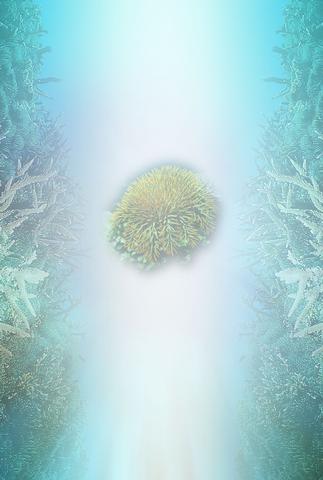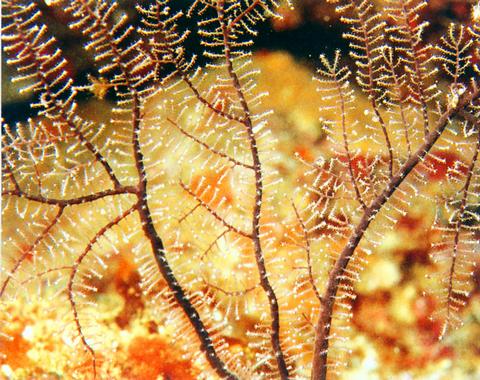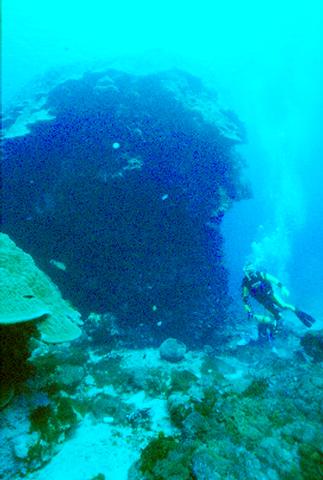Several years ago, Professor Soong Ke-yi (
Such international attention for something that cannot easily be visited led to the creation of the National Museum of Marine Biology and Aquarium (
Situated at the southern tip of Taiwan, Kenting is privileged to have the first encounter with the famously warm black tide. When it reaches the Hengchun Peninsula (

"If there was no coral reef, there would be no Kenting," said Professor Dai Chang-feng (
When people visit this exquisitely beautiful national park, coral can be seen almost everywhere on the ground and surrounding hillsides. Before being forced above the surf through millennia of tectonic movements, the reefs were home to the most varied species of marine organisms in the world.
However, two recent typhoons, Toraji and Nari, devastated not only the land in Taiwan, but its surrounding reefs as well. A layer of silt as much as a meter thick now lies where Taiwan's rivers meet the sea. Coral-rich Kenting is no exception. The torrent of rain brought by the typhoons caused serious flooding and mudslides and carried huge amounts of silt and debris downriver to the shallow-water areas in Kenting, where precious coral reefs and abundant marine life dwell.

According to a study by marine biologist Cheng Ming-siou (鄭明修), there are approximately 2,350 species of fish living in the South China Sea and Pacific Ocean areas immediately surrounding Taiwan. Of these, 1,500 mostly smaller-sized fish live in and around coral reefs.
Nonetheless, the ecological impact on the coral reefs in Kenting brought by these two typhoons is immeasurable, as Professor Dai, who is also president of the Taiwan Coral Reef Society, points out. "We have paid a lot of attention to disaster areas on land since the 921 earthquake occurred in 1999," he told the Taipei Times. "It's about time we turn our attention to the even greater disasters under the sea and in Taiwan's coastal regions."
Ecologically conscious people used to blame Nuclear Power Plant No. 3 for coral bleaching in Kenting. Yet the high-temperature water released by the plant into Kenting's Nanwan (南灣), or South Bay is not the only killer. With nearly four million people flocking to Kenting every year, many scuba divers carelessly trample on the shallow-water reefs, causing serious damage. Some miscreants even carve their names in the coral.

Perhaps the most serious factor is the silt deposits flush down from inland areas either by tropical storms or seasonal rainfall. Large amounts of silt, coupled with an increasing amount of sewage caused from over-development of resort hotels and recreational areas, are suffocating coral and other living organisms. Unenforced soil-conservation laws and construction debris are notoriously persistent problems for the region. All these man-made hazards lie waiting for heavy rainfall to wash them into nearby rivers and carry them to the sea.
All of these problems result either directly or indirectly in the death of various species of coral reef, which are extremely sensitive to environmental changes.The worldwide phenomenon of coral bleaching, perhaps due to the sudden global rise in sea-water temperatures detected by 35 different countries between 1997 and 1998, has not spared Kenting.
However, compared with silt deposits that envelop the seabed and choke coral reefs, the problem of coral bleaching seems insignificant.

Thus, many oceanography scholars both in Taiwan and abroad are now sending out warnings that within some two decades the vast coral reefs found in Kenting and the surrounding vicinity may die out completely.
Coral and its symbiotic algaeconsume dioxide in the ocean and greatly and helps counteract the greenhouse effect. The ideal seawater temperature for coral to grow is between 23C and 28C. If the temperature is lower than 18C or higher than 30C, it begins to die.
Each year, most of the coral in Kenting will release its sperm and eggs into the seawater where it is fertilized during the 15th and the 22nd night of the third lunar month.

PHOTO COURTESY OF DAI CHANG-FENG
In tropical seas, coral plays a similar role to plants found on land. The reefs are often referred to as the rainforests of the ocean. According to Dai, a few tall branching corals form the main structure of the reef, with various branchings scattered at lower levels. Together, they form a complex, three-dimensional structure that provides a habitat for fish, crustaceans, and other sea life. In this way, the role of coral on any given reef is very similar to that of a canopy of trees in a forest.
Coral can be classified into three major categories; stony coral, soft coral and gorgonians. The classifications are based on the coral's external features, with stony coral being the hard variety, soft coral being of a spongy texture and gorgonians the beautiful tree-like structures so admired by divers. Stony coral contains high concentrations of calcium carbonate and plays a key role in coral build-up.
"There are approximately 700 known species of stony coral in the world," Dai points out. "Of which 250 species can be found in the ocean at Kenting National Park."

PHOTO COURTESY OF SOONG KE-YI
Coral reef formation is influenced by a number of natural factors, including the temperature of the sea, light intensity, nutrient content and ocean currents. Only when these factors combine to form a suitable underwater environment can coral reefs take shape.
Reefs, like the coral that grows on them, are also divided into three categories; fringing reefs, barrier reefs and atolls. This system of classification has remained unchanged since first being set down by Charles Darwin. Reefs occupy a mere 0.3 percent of the total surface area of the world's oceans. Most are found in shallow water and are consequently not far from shore.
The process of reef formation begins with deposits of calcium carbonate. What follows is the slow physical growth of coral on the reefs with some, such as the Acropora species, growing as much as 20cm each year, while others, such as the spherical coral, growing less than a single centimeter over the course of a year. Such slow production of delicate beauty makes coral reefs seem like the Faberge eggs of the sea.
However, the colorful world of coral reefs are the heavenly habitat of numerous fish and other living creatures. Without the support of a lively ecosystem, both the fish and coral would simply disappear.
A lifeless ocean surrounding Kenting National Park, with coral reefs blanched a ghastly white like tombstones, seems unimaginable. Yet the day is drawing ever nearer if human indifference persists.
Due to overhasty industrial development, 38 percent of Taiwan's natural coastline has been covered over by cement embankments in the past 20 years. If the trend is allowed to continue, the beautiful coral reefs around southern and western Taiwan are doomed.
With the gradual disappearance of coral reefs, Taiwan's budding marine eco-tourism will be dealt a lethal blow, as will the inshore fishing industry. Most of all, the disappearance of coral reefs surrounding Taiwan would be an irreplaceable loss for one of the Earth's most beautiful and varied ecological systems.

May 26 to June 1 When the Qing Dynasty first took control over many parts of Taiwan in 1684, it roughly continued the Kingdom of Tungning’s administrative borders (see below), setting up one prefecture and three counties. The actual area of control covered today’s Chiayi, Tainan and Kaohsiung. The administrative center was in Taiwan Prefecture, in today’s Tainan. But as Han settlement expanded and due to rebellions and other international incidents, the administrative units became more complex. By the time Taiwan became a province of the Qing in 1887, there were three prefectures, eleven counties, three subprefectures and one directly-administered prefecture, with

It’s an enormous dome of colorful glass, something between the Sistine Chapel and a Marc Chagall fresco. And yet, it’s just a subway station. Formosa Boulevard is the heart of Kaohsiung’s mass transit system. In metro terms, it’s modest: the only transfer station in a network with just two lines. But it’s a landmark nonetheless: a civic space that serves as much more than a point of transit. On a hot Sunday, the corridors and vast halls are filled with a market selling everything from second-hand clothes to toys and house decorations. It’s just one of the many events the station hosts,

Among Thailand’s Chinese Nationalist Party (KMT) villages, a certain rivalry exists between Arunothai, the largest of these villages, and Mae Salong, which is currently the most prosperous. Historically, the rivalry stems from a split in KMT military factions in the early 1960s, which divided command and opium territories after Chiang Kai-shek (蔣介石) cut off open support in 1961 due to international pressure (see part two, “The KMT opium lords of the Golden Triangle,” on May 20). But today this rivalry manifests as a different kind of split, with Arunothai leading a pro-China faction and Mae Salong staunchly aligned to Taiwan.

Two moves show Taichung Mayor Lu Shiow-yen (盧秀燕) is gunning for Chinese Nationalist Party (KMT) party chair and the 2028 presidential election. Technically, these are not yet “officially” official, but by the rules of Taiwan politics, she is now on the dance floor. Earlier this month Lu confirmed in an interview in Japan’s Nikkei that she was considering running for KMT chair. This is not new news, but according to reports from her camp she previously was still considering the case for and against running. By choosing a respected, international news outlet, she declared it to the world. While the outside world